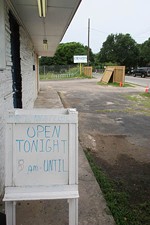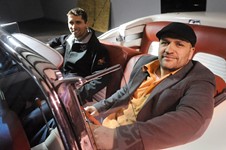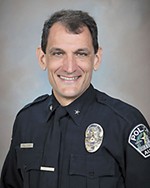Carter Called Home Before Fatal Police Shooting
Lawsuit questions APD's version of shooting
By Jordan Smith, Fri., Oct. 21, 2011
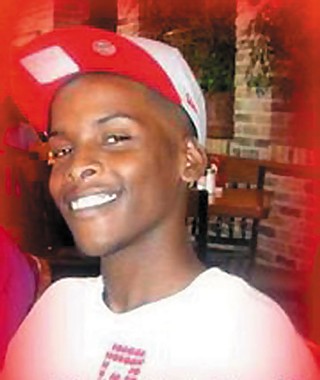
By all accounts, 20-year-old Byron Carter was a nice guy, says attorney Adam Loewy. He was close to his family, especially his grandmothers, who helped raise him. He lived off of Manor Road and attended LBJ High School, though he dropped out in his final year and never graduated. Still, he always held a job and worked hard to support his 1-year-old son, Byron Carter III. He was quiet and he didn't start trouble, the family has said. According to the Austin Police Department, Carter did have a prior arrest record, although the family says he generally avoided trouble.
On the evening of May 30, he was out with a younger friend (a 16-year-old who has not been named publicly because of his age) visiting a friend's place just east of I-35. At roughly 10:45pm, Carter called his grandmother to say he was on his way home. Roughly 15 minutes later, Carter was shot four times by APD Officer Nathan Wagner as he sat in the passenger seat of the red car driven by his friend. The friend, who was hit in the arm by a bullet, drove away, dumping the car several blocks east a few minutes later. He lived; Carter died.
Exactly why Carter died is now in question. According to a federal civil rights lawsuit filed last week by Loewy on behalf of Carter's family, including his young son, the family believes Carter was the victim of excessive police force after being targeted "simply" because he and his friend "were young, African-American males in a gentrified part of Downtown Austin." The family is suing Wagner individually, for the use of excessive force, and the city, for failing to adequately train and oversee APD officers that it knows have a history of employing "excessive force against minorities," according to the complaint.
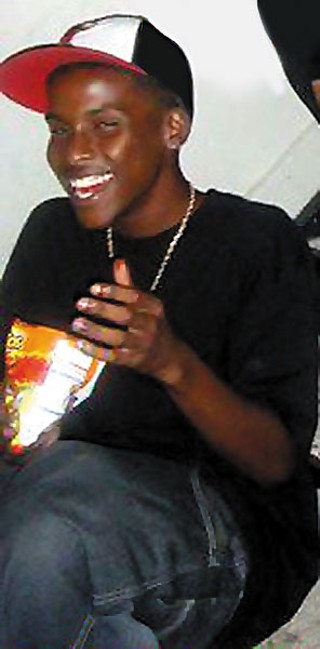
According to police, Carter and his teen companion were spotted by Wagner and his bike-cop partner, Officer Jeffrey Rodriguez, as they walked near an apartment complex just off the highway between East Seventh and Eighth streets. The officers were patrolling for car burglars and spotted the pair casing vehicles parked near the complex, police have said. The officers followed the two but at some point lost sight of them. When they finally spotted the pair again, the teen and Carter were already in a car – police thought it might be stolen, they said the night of the shooting. With the officers flanking the vehicle, the teen driver tried to pull away from the curb, striking Rodriguez, who suffered a ruptured Achilles tendon. Wagner, believing his partner was pinned beneath the car and would be dragged as they pulled away, fired repeatedly into the vehicle, police said, killing Carter and wounding the driver.
Frankly, says Loewy, that story has never made sense to him. For starters, the pair had their own car – why would they be targeting cars if they had their own ride, he asks. Also, he says, the notion that the boys were up to no good is belied by the phone call Carter made to his grandmother just before the shooting. "Equally important" to the fact that they were actually driving their own car, Loewy wrote in an email, "when someone is on [an] alleged crime spree, they generally don't call their grandmother at 10:45pm and tell her [they] are coming home, like happened here." According to the lawsuit, Carter and his friend were simply walking back to their car to go home, unaware that the police were following them. They got into the car and were beginning to pull away from the curb when, "out of nowhere, and from a dimly lit area," Wagner and Rodriguez ran "up to the car with their guns drawn." Neither identified himself as police, reads the pleading, and instead, "without any warning whatsoever," Wagner opened fire into the car, striking Carter "repeatedly in the head and body."
Indeed, the results of Carter's autopsy suggest that the shooting incident isn't as clear-cut as police have suggested. According to the report, which the Chronicle has reviewed, Carter sustained four wounds, including one shot to the head – traveling from the left rear side of the skull and out through the right temporal region – and one to the rear left shoulder. Two additional shots hit Carter: one in his lower abdomen and a second that shattered his femur. The spread of the wounds on Carter – and the fact that the teen driver was struck just once, in his arm – worries Loewy. (Although officials originally declined to release the autopsy to Loewy, last week they changed course and gave him a copy of the report.) Did Wagner panic and fire without drawing a bead on the driver? Was he just a bad shot? Did he fire randomly and continue to do so without having any idea what he would strike? At this point, he says, he and the Carter family have far more questions than they have answers, though Loewy believes it is significant that a Travis County grand jury declined to indict the 16-year-old on any charges, including aggravated assault of a police officer, a first-degree felony. "The fact that the kid wasn't indicted for anything is huge," Loewy said.
The lawsuit also argues that police regularly use excessive force disproportionately against minorities and that the city of Austin has failed to ensure police have proper training and oversight to correct the problem. The "known and obvious consequence of these policies was that APD officers would be placed in recurring situations in which the constitutional violations described within this complaint would result," reads the suit.
The city has declined to comment on the lawsuit but has retained outside attorney Dan Richards to handle the suit, fairly atypical in these kinds of civil rights cases, which are usually handled by the city's legal team. The move to hire Richards was made "primarily on the workload capacity" of the city's litigation team, city spokesman Reyne Telles said in an email.
Got something to say on the subject? Send a letter to the editor.






